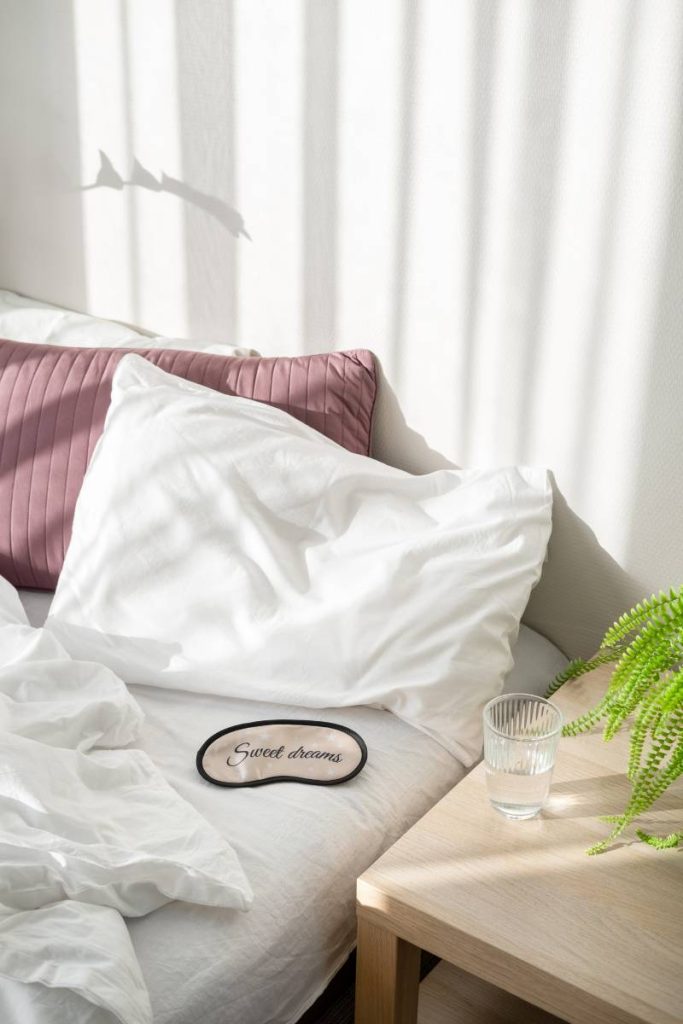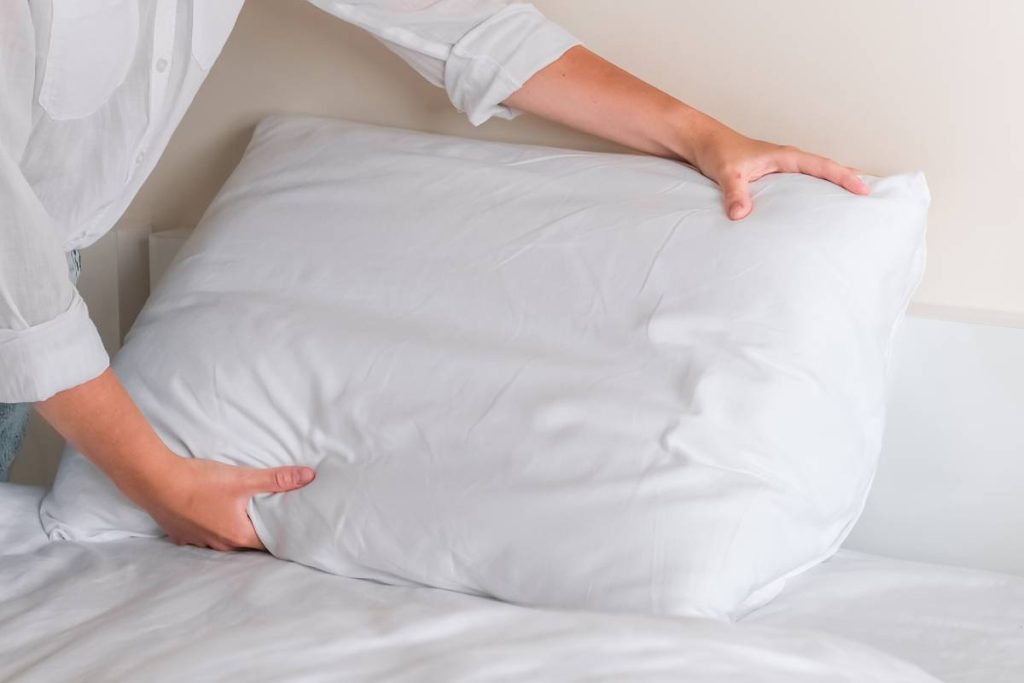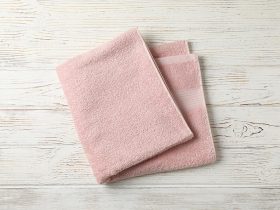At the end of a tiring day, all you want is to snuggle into bed, rest your head on a pillow, and drift off to sleep. Night after night, your pillows provide comfort, but they also gather dust, sweat, skin cells, and allergens. It’s not the most pleasant thought, right? Take a moment to inspect your pillows – they might not be as fresh and fluffy as they used to be. If they’re feeling flat, lumpy, or starting to look yellow, it’s time to take action.
While you might diligently wash your bed linens and towels every couple of weeks, when was the last time you cleaned your pillows? If you’re unsure about the proper way to wash them or when it’s time to replace them altogether, keep reading for answers to these questions and more.
Why should I need to replace my pillows?
Pillows are often overlooked when it comes to household items that need replacing. We spend a significant portion of our lives resting our heads on these fluffy companions, yet many of us are guilty of holding onto them for far too long. But why exactly should you replace your pillows? Let’s delve into the reasons behind this often neglected aspect of bedding hygiene.
 Hygiene Matters: Over time, pillows accumulate sweat, body oils, dead skin cells, and even dust mites. These elements create an environment ripe for bacterial growth, leading to unpleasant odours and potential health issues like allergies and skin irritation.
Hygiene Matters: Over time, pillows accumulate sweat, body oils, dead skin cells, and even dust mites. These elements create an environment ripe for bacterial growth, leading to unpleasant odours and potential health issues like allergies and skin irritation.- Losing Support: Ever noticed your once plump pillow feeling flat and lifeless? Pillows lose their shape and support over time, especially if they’re regularly compressed under the weight of your head each night. This can result in poor neck alignment and discomfort, leading to restless sleep and even neck pain.
- Allergen Accumulation: Dust mites, a common allergen trigger, love to make themselves at home in pillows. These microscopic critters thrive in warm, humid environments and feed on dead skin cells. Regular washing might help, but it’s not a permanent solution. Replacing pillows periodically can significantly reduce exposure to allergens, promoting better respiratory health.
- Mould and Mildew: Moisture from sweat or humidity can seep into pillows, creating the perfect breeding ground for mould and mildew. Not only does this contribute to unpleasant smells, but it can also pose serious health risks, particularly for individuals with respiratory conditions like asthma.
- Increased Comfort: New pillows offer better support and comfort compared to their worn-out counterparts. Investing in a fresh pillow can enhance your sleep quality, ensuring you wake up feeling refreshed and rejuvenated.
- Improved Sleep Quality: A comfortable sleeping environment is essential for quality rest. A worn-out pillow can disrupt your sleep by causing discomfort, tossing, and turning. By replacing your pillows regularly, you can optimize your sleep environment and enjoy more restful nights.
- Maintaining Skin Health: Pillowcases accumulate dirt, oil, and bacteria from your facial skin and hair. Sleeping on a clean, fresh pillow can help prevent breakouts and maintain healthier skin overall.
- Long-Term Cost Savings: While it may seem like a minor expense, replacing pillows periodically can save you money in the long run. Poor-quality sleep due to uncomfortable pillows can lead to health issues and decreased productivity, resulting in potential medical expenses and lost wages.
- Environmental Impact: Opting for high-quality pillows made from sustainable materials and recycling old ones can reduce environmental impact. Many modern pillows are designed with eco-friendly materials and production methods, offering a more sustainable option for conscientious consumers.
- Personal Hygiene: Just like changing your toothbrush regularly, replacing your pillows is part of good personal hygiene. It’s a simple yet effective way to maintain a clean and healthy sleeping environment.
So, wrapping things up, it’s super important to switch out your pillows now and then. It’s all about keeping things clean, comfy, and making sure you’re taking care of yourself. Fresh pillows mean you’re in for some top-notch zzz’s, better health vibes, and that awesome feeling of knowing you’ve got a squeaky-clean spot to lay your head at night.

How often should I wash or replace my pillows?
To ensure a clean and comfortable sleep environment, it’s essential to know how often you should wash or replace your pillows. Let’s break it down.
- Washing Frequency:
- Regular Pillowcases: Pillowcases should ideally be washed once a week to remove sweat, oils, and dirt accumulated from skin and hair.
- Pillow Protectors: These covers act as an additional barrier against allergens and stains. Wash them every 2-4 weeks, or more frequently if needed.
- Pillows: Most pillows are machine washable. Depending on the material, aim to wash them every 3-6 months to remove dust mites, bacteria, and odours. Follow the care instructions on the label for the best results.
- Replacement Timeline:
- Standard Pillows: Over time, pillows lose their shape and support, leading to discomfort and poor sleep quality. Replace standard pillows every 1-2 years, or when they no longer provide adequate support.
- Memory Foam Pillows: These pillows can last longer due to their durable material. Replace memory foam pillows every 2-3 years, or as needed if they start to lose shape or become lumpy.
- Down or Feather Pillows: With proper care, these pillows can last 4-6 years. However, they may need more frequent fluffing and occasional professional cleaning to maintain their loft and freshness.
- Allergy or Health Concerns: If you suffer from allergies or respiratory issues, consider replacing pillows more frequently (every 6-12 months) to minimize exposure to allergens and bacteria.
- Signs It’s Time for a Replacement:
- Flattened or Lumpy: If your pillow no longer retains its original shape or feels lumpy and uneven, it’s time for a new one.
- Yellowing or Staining: Discoloration or stains on the pillow indicate the presence of sweat, oils, and other bodily fluids that can harbour bacteria.
- Persistent Odors: Even after washing, if your pillow retains a musty or unpleasant odour, it’s a sign that it’s reached the end of its lifespan.
- Increased Allergy Symptoms: If you notice a sudden increase in allergy symptoms or respiratory issues, your pillow may be to blame. Replace it promptly to improve indoor air quality and alleviate symptoms.
- Maintenance Tips:
- Fluff Daily: Fluffing your pillows daily helps maintain their loft and shape, prolonging their lifespan.
- Air Out: Periodically air out your pillows in the sun to remove moisture and kill bacteria naturally.
- Use Pillow Protectors: Invest in quality pillow protectors to prolong the life of your pillows and reduce the frequency of washing.
- Follow Care Instructions: Always follow the manufacturer’s care instructions when washing or drying pillows to avoid damage and ensure longevity.
So, here’s the deal: keep those pillows washed and swap ’em out when needed. It’s the secret sauce to that fresh, oh-so-cosy sleep haven. Stay on top of the fluff game, and you’ll be snoozing like a champ, waking up all bright-eyed and bushy-tailed.
It’s-time-to-change-that-pillows signs
Here are clear signs that it’s time to replace your pillow:
- Flattened or Lumpy Texture: When your pillow loses its shape and feels flat or lumpy, it means the filling has worn out. This lack of support can lead to discomfort in your head and neck.
- Persistent Allergies: Even after washing, pillows can still hold onto allergens. If you find yourself constantly sneezing, coughing, or experiencing congestion and watery eyes, it might be due to allergens trapped in your pillow fibres. It’s a sign that it’s time for a new pillow.
- Questionable Odours: If your pillow starts to smell funky, it could be harbouring bacteria. Washing might not solve the issue. If the odour persists even after cleaning, it’s best to get rid of the pillow.
- Visible Wear and Tear: Frayed edges, worn-out fabric, holes, or discolouration are all signs of an ageing pillow. When you notice these signs, it’s a clear indication that your pillow has seen better days and needs to be replaced.
- Waking Up with Aches and Pains: If you frequently wake up feeling sore or experiencing pain in your head, shoulders, or neck, it’s likely your pillow isn’t providing adequate support anymore. Upgrading to a new pillow can help you sleep more comfortably and wake up refreshed.
Keep an eye out for these signs to ensure you’re sleeping on a pillow that offers the support and comfort you need for a good night’s rest.

Tips to help your pillows last longer
- Invest in Pillow Protectors: Get yourself some good-quality pillow protectors. These not only shield your pillows from sweat, dirt, and allergens but also extend their cleanliness. Remember to wash the protectors every two weeks to maintain their effectiveness.
- Avoid Eating in Bed: Munching on snacks in bed might seem cosy, but it’s not great for your pillows. Crumbs and spills can deteriorate and stain the fabric and fibres, shortening the life of your pillows. Plus, who wants to sleep on a crumb-covered pillow?
- Regular Washing: Follow the care instructions provided by the manufacturer and wash your pillows regularly. Promptly clean up any spills or stains as they occur to prevent them from setting in.
- Choose Quality Pillowcases: Opt for pillowcases made from breathable materials like high-quality cotton. Synthetic fibres can trap moisture and dirt, leading to faster wear and tear.
- Fluff Them Up: Give your pillows a good fluff whenever you make your bed. This helps redistribute the filling, maintaining their shape and comfort.
- Keep Pets Away: As much as you adore your furry friends, their hair and dander can wreak havoc on your pillows. If your pet loves snuggling on pillows, consider getting them their own and keeping yours pet-free.
- Smart Storage: For extra pillows that aren’t in regular use, store them in a cool, dry place. Use storage bags to protect them from dust and dirt.
- Use Inserts for Throw Pillows: If you have decorative throw pillows, prolong their lifespan by using pillow inserts. This way, you can change out the inserts and keep the cover for years to come, saving you money and reducing waste.
Pillows care guide
Here’s a simple guide on caring for different types of pillows. Remember to always check the care instructions provided by the manufacturer for specific guidance.
Memory Foam:
- Spot clean or hand wash.
- Allow to air dry.
Microbead:
- Spot clean and machine wash on a gentle cycle using cold or warm water and a mild detergent.
- Partially dry on a medium or high setting, then allow to finish air drying.
Gel:
- Spot clean and machine wash on a gentle cycle using cold or warm water and a mild detergent.
- Air dry or dry on a medium or high setting.
Polyester:
- Spot clean and machine wash on a gentle cycle using cold or warm water and a gentle detergent.
- Dry on a medium or high setting.
Down:
- Spot clean and machine wash on a gentle cycle using cold or warm water and a gentle detergent.
- Dry on a medium or high setting.
Feather:
- Spot clean and machine wash on a gentle cycle using cold or warm water and a mild detergent.
- Dry on a medium or high setting.
Buckwheat:
- Hand wash the cover and air dry the buckwheat filler outside in direct sunlight.
Bamboo:
- Spot clean and machine wash on a gentle cycle using cold or warm water and a gentle detergent.
- Air dry only.
Which pillow materials are the most durable?
Just like with mattresses and bed linens, the material of your pillow plays a big role in how long it lasts. While pillows come in various materials like foam, gel, feathers, and polyester, some stand out for their longevity, keeping your pillow feeling fresh for longer.
High-quality memory foam and latex pillows typically outlast others. They maintain their shape, support, and appearance for an extended period. However, even durable pillows need proper care and maintenance to stay in good condition. On the other hand, polyester fiberfill pillows, though budget-friendly, tend to clump and deteriorate faster. When shopping for pillows, consider these factors to ensure you get ones that will last.



























